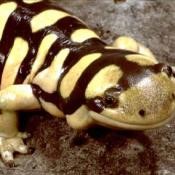15: Barred Tiger Salamander
Friends,
I write to you from Arapahoe, Ute, and Cheyenne land. I am interested in learning about the different animals that live in the place where I was born. I want to mention that biological classification as taught by western science has its roots in racism, sexism, and transphobia – here’s a good explainer about why.
I am VERY excited to announce today’s animal, Colorado’s OFFICIAL STATE AMPHIBIAN: the Barred Tiger Salamander (Ambystoma mavortium). They are also our only salamander. Look at this guy:

Several years ago, I was at work in a very small office and one of my coworkers suddenly looked out the front window and said, “Is that a salamander in the parking lot?” We went outside and found a very hot one of these guys struggling on the pavement. We didn’t know what to do and tried to shuffle him into the shade under a car to cool down and went back inside. A few minutes later another coworker called me over to her desk and pointed to the area under it where her feet sat. She very carefully revealed a Tupperware with some water in it and – the salamander! We did some online research, found a nearby stream on google maps, carried him over there on the premise of wanting to stretch our legs, and released him. Here’s hoping that he lived a long and fruitful life. He looked a LOT like that photo down to his big salamander smile.
Barred Tiger Salamanders not only have a winning smile, they are also one of the longest varieties of salamanders in the entire world. I’m not sure how our friend wound up in the parking lot during the workday, because they are primarily nocturnal and like to live in cool, damp burrows.
Here’s a fascinating thing about salamanders: they practice something called facultative neoteny. This means that they can choose to remain in their gilled, aquatic, larval stage for the entirety of their lives, or become terrestrial, depending on environmental factors – so for example, if it is cold enough that moving onto land would be detrimental to life, they will retain their aquatic form.